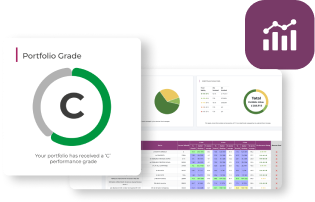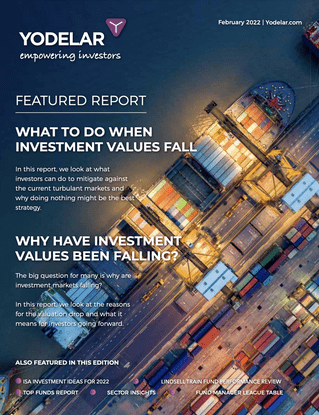- Delaying contributions can reduce your retirement pot by over 70%.
- Even small monthly payments, when consistent, can add six-figure value in retirement.
- Many pension portfolios hold underperforming funds for years without review.
- Poor fund selection is one of the biggest causes of lost pension growth.
- Diversification is essential - too many investors are overexposed to a single region or sector.
- Aligning risk to your life stage is key to avoiding shortfalls at retirement.
For most UK investors, a pension is their single most important long-term financial asset. Yet despite its critical role in shaping retirement outcomes, too many people make costly missteps that undermine its value. These mistakes aren't always obvious. Often, they stem from misconceptions, inaction, or overconfidence.
In this article, we identify 7 of the most common pension-related errors—mistakes that can compound over time and lead to serious financial shortfalls. Whether you’re starting to build your pension pot or approaching retirement, understanding these pitfalls can help you make better, more informed decisions.
1. Delaying Pension Contributions
Of all the common pension mistakes, delaying contributions is arguably the most financially damaging. In the early stages of life, retirement often feels distant and abstract, which makes it easy to prioritise short-term financial goals such as homeownership, holidays or debt repayment. However, the longer contributions are postponed, the more investors sacrifice what is arguably their most valuable asset in retirement planning: time.
The rationale is straightforward. Compound growth rewards time, not timing. The earlier money is invested, the longer it has to benefit from reinvested returns. The effect is so powerful that an investor contributing modestly in their twenties can end up with a larger retirement pot than someone who saves far more aggressively from their forties onwards.
For example, investing a one-off £5,000 at age 25 with an average annual return of 6% could grow to £57,435 by age 65. Delaying that same investment until age 45 reduces the final value to just £16,035. This represents a 72% shortfall purely due to lost time, not poor investment returns.
Regular contributions tell a similar story. A 25-year-old saving £200 per month could accumulate a pension pot worth approximately £384,000 by age 65, assuming 5% annual growth after fees. If the same contributions begin at age 40, the final pot would be just £151,000, despite more than half the total amount still being paid in.
This issue also highlights a broader behavioural challenge: the habit of saving. Starting early helps instil financial discipline and reduces the pressure to catch up later in life, when other responsibilities are often more pressing and the window for growth is shorter.

The conclusion is clear. Starting early has a greater impact than starting big. Even small contributions in your twenties or thirties can grow into meaningful retirement assets, whereas those who delay may need to contribute substantially more and accept higher levels of investment risk to achieve the same outcome.
2. Dismissing Small Contributions
Higher net worth investors often focus on larger investment decisions, and in doing so, may overlook the long-term value of consistent pension contributions. But while lump sum investing has its place, the strategic use of regular monthly contributions - especially when made at higher levels - is one of the most effective tools for building long-term, tax-efficient wealth.
The reality is that many investors with £250,000 or more in assets can afford to contribute significantly more than the standard minimum. Yet the potential value of doing so within a pension wrapper is often underestimated. For example, contributing an additional £250 per month into a pension over 20 years, assuming a 5% net annual return, would result in a pension pot of more than £100,000. That figure excludes any tax relief - which, for higher or additional-rate taxpayers, makes the real cost of that contribution substantially lower.
Importantly, that £100,000 is not just a figure on a statement. It represents a tax-advantaged, ring-fenced pool of capital, grown through disciplined structuring rather than risk-taking. And because pensions benefit from tax-free growth and tax relief on contributions, this type of investing becomes especially attractive for those who are already utilising ISA allowances or seeking to improve overall tax efficiency.
This approach also serves another critical purpose: consistency. Rather than relying solely on one-off investment opportunities or end-of-year top-ups, embedding a structured monthly contribution strategy into your wider financial plan helps create forward momentum. It also reduces the risk of underfunding, particularly for those who intend to retire earlier or draw flexibly in later life.
For investors with capacity, adding to pensions regularly - even at £250 a month - is not a question of affordability, but of optimisation. It is a simple yet often overlooked step that, when applied consistently, compounds into meaningful long-term value and improves retirement outcomes without requiring higher risk or complexity.
3. Misunderstanding the Role of Pensions
One of the most common misconceptions among investors is viewing a pension as the investment itself, rather than recognising it as what it truly is - a tax-efficient wrapper that holds underlying investments. This distinction is critical. The wrapper provides structure and tax advantages, but the growth and ultimate value of your pension depend entirely on the quality and performance of the investments held within it.
Most pensions in the UK today operate on a defined contribution basis. This means the individual, not the employer or provider, is responsible for selecting and managing the underlying investments. What you get out at retirement is determined not by the fact that you have a pension, but by how well those investments have performed over time.
Yet even among experienced investors, it is common to find pensions left in default strategies, neglected portfolios, or low-growth funds that fail to reflect the investor’s actual goals. It is not unusual to see six-figure pension pots sitting in outdated multi-asset funds, or overly conservative allocations that were never adjusted as circumstances changed. In some cases, investors are unaware that a large portion of their pension is sitting in cash, earning little to no real return year after year.
Another issue that often goes unnoticed is cost. High fund charges, hidden platform fees, and inefficient advice structures can quietly erode pension value over time. These costs compound, just like investment returns. Without proper oversight, even relatively well-funded pensions can underperform by tens of thousands of pounds over the long term.
To make a pension work efficiently, it should be treated as a dynamic investment portfolio. That means monitoring fund performance, aligning asset allocation with your risk profile and time horizon, and making informed changes where necessary. A pension should evolve as your circumstances change. It should not be static, ignored, or left to drift.
A pension is not just a savings vehicle. It is a highly tax-efficient investment account. When used with discipline, it becomes one of the most powerful tools for long-term wealth creation and retirement planning. When misunderstood or overlooked, it can quietly become one of the most inefficient.
4. Poor Fund Selection
The quality of the funds held within a pension portfolio plays a central role in determining long-term performance. Yet poor fund selection remains one of the most persistent and costly issues affecting UK investors. Our analysis of more than 40,000 investor portfolios identified that over 90 percent contain funds that have consistently underperformed their sector peers. In most cases, this inefficiency goes unnoticed for years, quietly limiting growth potential and eroding long-term value.
Each investment sector contains a wide spread of competing funds, often managed by different groups, yet all targeting similar market exposures. The difference in performance between them can be significant. Some funds deliver consistently strong returns through sound strategy and active risk management, while others fall well short of their peers. Even in diversified portfolios, holding a number of underperforming funds can create substantial drag on returns.
The table below illustrates this point clearly. It shows the average five-year growth of the top 50 percent and bottom 50 percent of funds across five of the most popular Investment Association sectors:
As the data shows, the performance gap is wide. In the IA Global sector, the top half of funds delivered an average return of 76.45 percent over five years, compared to just 36.53 percent for the bottom half. In IA North America, the top performers returned 89.37 percent, while the bottom half averaged 52.43 percent. These disparities exist across every sector and have meaningful consequences when compounded over time.
The issue is not simply that poor funds exist. The real problem is that they are rarely challenged. Many portfolios are built using generic models, outdated fund selections, or default strategies that are never reviewed. Investors assume their portfolio is working efficiently, yet in reality, substandard funds remain in place while stronger alternatives are overlooked.
For high net worth investors, the consequences are magnified. A portfolio growing at 3 percent annually instead of 5 percent could be worth more than £200,000 less over a 25-year period. That shortfall is not driven by market risk, but by lack of fund efficiency and poor oversight.
The solution does not require higher risk. It requires better selection. An evidence-based approach to fund analysis, with regular performance reviews, benchmarking, and manager assessment, is essential. The goal is not to chase short-term winners, but to identify resilient funds that consistently outperform their sector average and align with the investor’s long-term objectives.

The impact of fund selection on retirement outcomes cannot be overstated. It is not a technical detail, it is a financial cornerstone. A portfolio that is built, managed and maintained with discipline is far more likely to deliver the long-term results that serious investors expect.
5. Poor Diversification
One of the most overlooked threats to long-term pension performance is poor diversification. Overexposure to a single fund, asset class, or region can leave a portfolio dangerously unbalanced. This is particularly common among UK investors, many of whom hold a disproportionate allocation to North America and technology. While this bias has been rewarded in recent years, it also increases vulnerability if those markets fall out of favour.
Diversification is not simply about owning a broad mix of funds. It is about ensuring that each fund has a clear and complementary role within the portfolio. Without proper oversight, investors may unknowingly hold multiple funds with similar exposures, resulting in unintentional overlap and hidden concentration risk. This is how portfolios that appear diversified on the surface often end up reliant on a small number of market themes beneath.
High-quality advice firms recognise this risk and address it through structured, evidence-led portfolio construction. Every fund selected is assessed not only on individual merit, but also on how it interacts with the broader portfolio. The aim is to combine managers, strategies, and styles that work effectively together - just like building a high-performing team. Some funds are chosen for growth potential, others for defensive qualities, and others for exposure to less correlated regions or sectors. Together, they create a balanced engine that is more resilient across market cycles.
Diversification does not guarantee positive returns in every market condition, but it reduces reliance on any single outcome. It smooths volatility, manages drawdowns, and helps protect capital - especially in the years approaching retirement when the cost of large losses becomes harder to recover from.
For investors with substantial pension assets, the importance of proper diversification cannot be overstated. It is not just a safety measure; it is a strategic discipline that underpins consistent, long-term success. Portfolios built with care, clarity, and purpose are far more likely to deliver dependable growth than those left exposed to narrow themes or unmanaged risk.
6. Mismatched Investment Risk
Getting your investment risk level right is one of the most important yet often overlooked aspects of pension planning. Too much risk later in life can lead to sharp, unrecoverable losses. Too little risk early on can limit growth and leave your pension pot underfunded.
Your pension strategy should evolve over time. In your 30s and 40s, taking more investment risk can make sense, as long-term market exposure tends to smooth out short-term volatility. But as retirement approaches, the priority shifts to protecting the value already built. Reducing risk in later years helps preserve capital and prepare for income drawdown.
The tables below model three investment strategies over 35 years, based on £500 monthly contributions and a £10,000 initial investment. Scenario 1 assumes steady average returns. Scenario 2 includes a market drop in year 34 to reflect a late-cycle downturn close to retirement.
In Scenario 1, the “Overly Cautious” strategy, averaging 3% annually, grows to £401,794. The “Too Aggressive” strategy, averaging 7%, grows to £994,247 - but only under ideal conditions with no downturns. The more balanced “Appropriate Risk” approach - higher growth early, lower risk later - achieves £829,075.

Scenario 2 shows what happens if markets fall just before retirement. The aggressive strategy drops to £747,290 - nearly £247,000 lower than in Scenario 1. The balanced strategy holds up better, finishing at £789,776. The cautious strategy sees only a small decline, ending at £389,926.

These examples are for illustration and do not include fees, tax relief, or inflation. But they clearly show the importance of adjusting your investment risk over time to balance against the inevitable ups and downs of investment markets.
How We Help Investors Avoid This Mistake
High-quality advice firms help eliminate this kind of risk mismatch through continuous oversight and regular risk profiling to ensure the most suitable risk model is always in place.
Getting the right risk level is not about being brave or cautious - it is about being precise. With the right oversight, your pension portfolio can grow consistently, avoid unnecessary shocks, and remain on track to meet your long-term objectives.
Find Out How We Can Help Optimise Your Pension
A Better Retirement Starts With Better Decisions
For most investors, their pension is the most important asset they will ever build - yet many are unsure whether it’s performing as well as it could. As we’ve shown, simple mistakes such as starting too late, contributing too little, or holding the wrong funds can quietly hold back growth and lead to disappointing outcomes at retirement.
These issues are common, but the good news is that they are also avoidable. With the right guidance and regular reviews, it’s possible to turn an underperforming pension into a well-structured, high-quality investment strategy. One that grows steadily, protects against unnecessary risks, and stays aligned to your long-term goals.
At Yodelar, we help investors understand how well their pension is working. We analyse each portfolio in detail, identify areas for improvement, and help create a clearer path to better retirement outcomes.
If you're not sure whether your pension is on track, now is the time to find out. A second opinion could make all the difference.

















